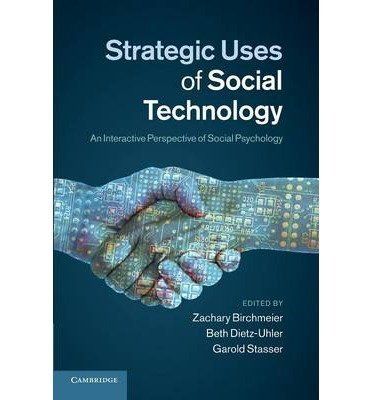The new communications technologies are developing at such a fast pace that it is difficult for research and theorizing to keep up. Although exploring the range of applications and instantiations of the latest forms of computer-mediated communication (CMC), texting, and video-based phone systems provides many useful insights, research and theorizing that lags behind the technological developments will run the risk of being phenomenon- and even technology-driven, making it difficult to anticipate new uses and consequences.

Spears, R., Lea, M., Postmes, T., & Wolbert, A. (2014) “A SIDE look at computer-mediated communication: Power and the gender divide”. In Zachary Birchmeier, Beth Dietz-Uhler, and Garold Stasser (Eds.). Strategic uses of social technology: An interactive perspective of social psychology. Cambridge: Cambridge University Press.
In this chapter we adopt a theory-focused approach to make some sense of the effects of the new technologies (as Kurt Lewin said there is nothing so practical as a good theory), and a primarily experimental methodology to test this. We focus on a theoretical framework that we have developed over a number of years to gain insights into the effects of computer-mediated communication in social and organizational settings: the SIDE model. We have found this model useful in helping to correct a tendency, in the literature on CMC in particular, to underestimate the role of social influences (broadly conceived) on and within these technologies, and an equal (and perhaps opposite) tendency to overestimate their capacity to counteract the impact of status and power.
In particular, we think this theoretical model has been useful in helping is to understand (and predict) some of the more counterintuitive findings about behavior when using computer-mediated communication. The idea that people actually become conforming when isolated from and anonymous to their group is a good example of such an effect explained by the SIDE model. Gender, which forms a key focus in the present chapter, also forms an interesting case study in this respect.
Much theorizing and research has proposed that women might become more assertive and less submissive when liberated by the anonymity of CMC. Our research suggests that this is not necessarily the case. The SIDE model helps to explicate when and why the technology may help disempowered groups to transcend inequalities of status and power, and when it leaves them more vulnerable to the power divide.
Of course people are not just passively exposed to the effects if technologies such as CMC – a key argument has been that they provide strategic opportunities for people to ‘manage’ their identities not available in “less mediated” face-to-face communication. So, for example, when women are given the chance to conceal or deceive about their gender identity, do they do this, and if so, with what effect? And are these strategies and effects similar for other groups and categories?
After outlining our model and providing some evidence of empirical support, we concentrate on “gender divide” as one important test case, in which the social and power dimensions of these communications technologies in particular can be examined in some detail. Finally we consider some of the implications of these findings for gender, as well as relations between groups divided by power and status in general.
About the book
Everyday we use text messaging, social networking tools, and electronic mail in work, educational, or personal settings. In this book, the editors explore how aspects of a situation combine with characteristics of a person to help explain our mediated social interactions. The person-by-situation interaction perspective recognizes the powerful role of the situation and social forces on behavior, thought, and emotion, but also acknowledges the importance of person variables in explaining social interaction, including power and gender, social influence, truth and deception, ostracism, and leadership.

